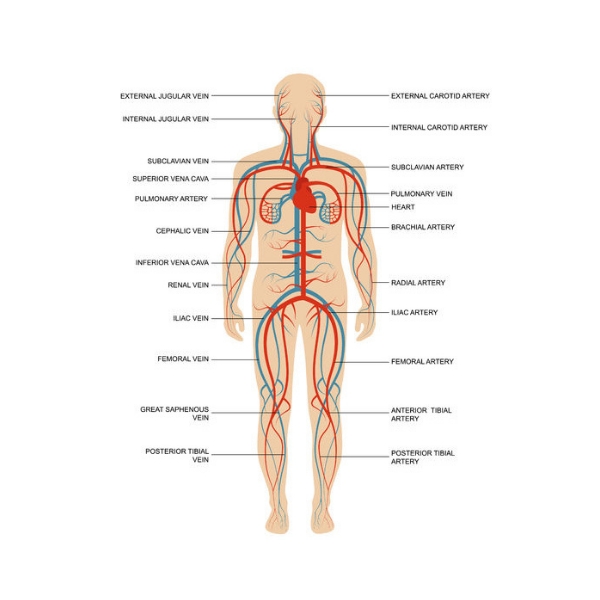What is Vascular & Endovascular Surgery ?
What is Vascular & Endovascular Surgery?
The human body depends on circulating blood to survive. The heart pumps blood out to the body through arteries. Veins bring blood back to the heart. In between, blood supplies the body with oxygen helps combat diseases, carries toxins to the kidneys and liver for filtering and more.
Vascular and endovascular refers to surgery on arteries and veins as well as within arteries and veins. This specialty deals with all types of vascular disease, including arterial occlusive disease, aneurysmal disease, and lymphatic and venous disorders.
Many conditions affect the complex highway of blood through the body, including blockages that can lead to stroke or heart attack, restricted blood flow due to narrowing of veins, varicose veins that have become dilated due to built up venous pressure and even kidney failure, which requires high-volume blood flow for use of a hemodialysis machine to replace kidney function.

Non-invasive Peripheral Vascular Lab/Equipment
- Diagnostic Peripheral Doppler Scans
- Therapeutic Compression
- ABI Tonometry
- Radiofrequency ablation for varicose veins
- Venous Laser Ablation
- Ultrasonic Debridement
Endovascular Surgery
- Endovascular aneurysm repair for Thoracic Abdominal Aortic Aneurysm
- Carotid/Renal/ Subclavian angiography and angioplasty with stenting
- Peripheral angiography with angioplasty of arm or leg arteries
- Aorta and Visceral artery angioplasty
- Venous angiography with IVC filter placement and angioplasty of stenotic veins.
- Management of Deep Vein Thrombosis (including placement of IVC filters/stents)
- Covered Stent Grafts for Trauma, Arterio-Venous Fistulae and Aneurysms
Vascular surgery deals with
- Management of Swollen Legs/DVT
Swollen legs due to deep vein thrombosis are a fairly common presentation. These are effectively treated by IVC filters, catheter-directed thrombolysis, compression stockings, compression therapy, and anticoagulation. A rare but serious complication of DVT is dislodgment of the clots from the legs to the lungs. - Angiography, Ballooning (Angioplasty), and Stenting
Angiography is a special dye test of the blood vessels. It is done under local anesthesia, on a mobile X-ray machine, or Cath Lab. Angiography of the legs, arm, or neck vessels is done regularly. - Doppler Scan
The blood vessels can also be studied by a noninvasive method – Doppler. It is similar to ultrasonography (USG) examination. This investigation also helps to detect peripheral vascular (PVD) or arterial blockage, DVT, varicose veins, etc. - Surgery for Varicose Veins
Varicose veins are prominent and tortuous veins in the legs, which can cause pain, ulcer, and swelling. They are managed by injection sclerotherapy, endovenous ablation or operation depending on the severity. These procedures are carried out as daycare procedures. - Surgery for Stroke Prevention
A stroke or brain attack usually occurs due to blockage of arteries in the neck, which carry blood to the brain (carotid artery). This blockage can be cleared by an operation called Carotid Endarterectomy. - Surgery for Aortic Aneurysms
An aortic aneurysm is a ballooning of the main artery of the body, usually in the abdomen. It is a major risk to life if it leaks or ruptures. Open surgery with a tube graft is performed to prevent this complication. This is an alternative to Endovascular surgery which is also performed routinely. - Leg Bypass Surgery
Leg arteries are blocked due to atherosclerosis, hardening of the arteries. Eventually, as the process progresses, your blood vessels can no longer supply the oxygen demands of your organs or muscles and symptoms may develop. During a bypass, the Vascular Surgeon creates a new pathway for blood flow using a graft. A graft is a portion of one of your veins or a man-made synthetic tube that your surgeon connects above and below a blockage to allow blood to pass around it. - Vascular traumas, both arterial and venous, are amenable to endovascular interventions in selected patients. Some of the serious, life-threatening injuries have yielded superior results, with marked decreases in mortality and morbidity. Endovascular interventions are still evolving and with the progress of technology, much vascular pathology will be treated with these minimally invasive procedures. We are well poised to assimilate any new technology and offer these to our patients. Both surgical and endovascular procedures are performed routinely. The two are complementary to each other and not mutually exclusive. Judicious patient selection, with one or the other form of intervention, sometimes combined (hybrid) procedures, is extremely important and preferably should be performed by a single team.
- Dialysis Access The most common treatment for chronic kidney disease or kidney failure is hemodialysis. One important step before starting regular hemodialysis sessions is to have a vascular surgeon prepare vascular access, which is the site on your body where blood is removed and returned during dialysis.
Save time, Save money, Be Healthy and Happy !
We can be your guide in the world of Vascular and Endovascular
Surgery!
